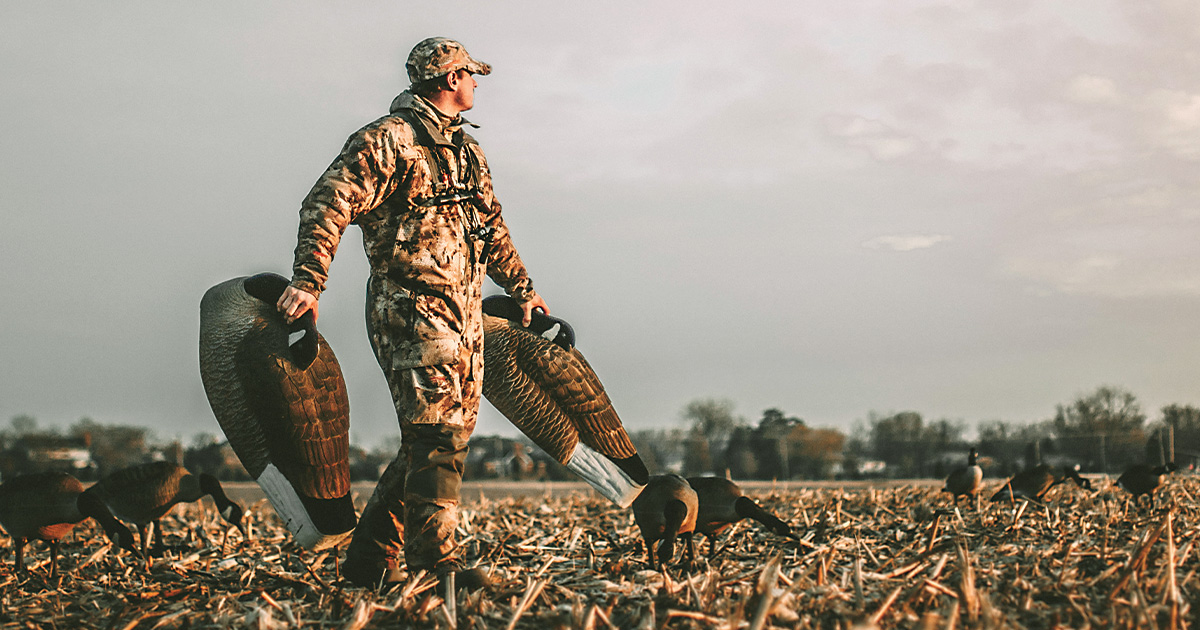Waterfowler's Journal: Homegrown Honkers
Some of today's best goose hunting might be closer than you think
Some of today's best goose hunting might be closer than you think


The rise of resident goose populations has led to increased hunting opportunities in many parts of the country.
Giant Canada geese were nearly extinct in the early 1900s, but that almost seems like an urban legend today—with an emphasis on urban. Drive past corn fields, golf courses, or parks on the outskirts of just about any Midwestern town and chances are you’ll see more honkers than pigeons.
Few wildlife species have done a better job of thriving near large human population centers than Canada geese, and not just in the corn belt. Across the country, Canada geese have become well adapted to feeding on manicured lawns and suburban crop fields. They can often be found roosting on rivers, golf course water hazards, and power plant lakes. With open water and abundant food available all winter, many urban, or “resident,” geese have little reason to embark on traditional migrations. They nest and raise broods in these areas and, during winter, attract migrating geese traveling from points farther north.
This scenario has created some incredible—but challenging—hunting opportunities. While traditional wintering areas like southern Illinois no longer see the mass goose migrations of decades ago, overall goose numbers have exploded, thanks to these resident populations. Many states have even increased hunting opportunities to control goose numbers.
Former world champion goose caller Richie McKnight, of Dawson Springs, Kentucky, has watched these changes unfold. McKnight cut his teeth in the southern Illinois goose scene as a guide and contest caller when he was in his early 20s. He’s continued to work as a pro-staffer, guide, and call maker for various companies over the years and is now the owner of Traffic Hunters, a custom call and video production brand.
One of McKnight’s favorite goose haunts is around Braidwood, Illinois. Braidwood is known for a nuclear power facility with a large cooling lake that never freezes, providing open water even during severe winter weather. McKnight has been hunting in the area since the 1990s. He says that although the abundant corn fields in the surrounding countryside look the part of rural Illinois, the Chicago skyline is just up the road, and most of the geese they hunt are raised locally. Hunters accustomed to decoying migrators have had to adapt.
“The birds just don’t migrate like they used to,” McKnight says. “Used to be, the geese were really spread out across the state, and we had fresh migrations every couple of weeks. So the hunting pressure was more evenly spread out. Now, all the geese stay in one spot, and everyone goes to them.”
McKnight adds that because of the concentrated hunting pressure, it doesn’t take long for the geese to catch on, which is true wherever you’re hunting resident honkers. Frequent adjustments to your hunting strategy are required to be successful. Recently, McKnight has made substantial changes to his decoy spread. I hunted with him at Braidwood 15 years ago, and we shot daily limits of birds over a giant spread of Big Foot full-body decoys, supplemented with silhouettes, that stayed out all season. But these days, McKnight has much better success with two dozen highly realistic full-bodies, which he picks up and moves around daily.
A more subtle approach to calling and flagging has helped as well. “There are probably 15 other goose spreads within a mile of us,” McKnight says. “Last season I drove around, watching and listening, and as soon as geese would come out from the lake, hunters would start flagging and calling as hard as they could from a half mile away. So we started letting the geese get over the field and not calling much until they got to us. Then we’d ease into the calling. Some groups we’d even let get past us before we’d call, and then they’d flip and come right back.”
Many urban goose hunters take a more mobile approach, scouting for birds that are feeding in recently cut crop fields or loafing on pasture ponds, and then setting up with layout or A-frame blinds. But the takeaway is the same: when the hunting pressure is heavy, local geese catch on quickly. If the urban geese you’re hunting aren’t responding, note what the competition is doing and try something a little different.
Ducks Unlimited uses cookies to enhance your browsing experience, optimize site functionality, analyze traffic, and deliver personalized advertising through third parties. By continuing to use this site, you agree to our use of cookies. View Privacy Policy